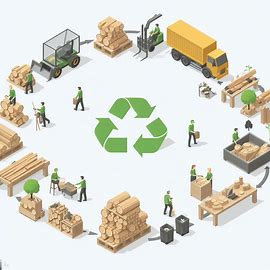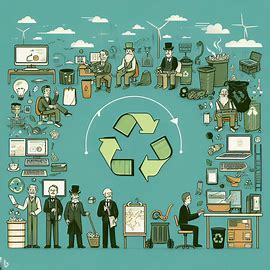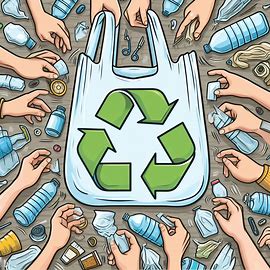Is Wood Recyclable? “Unlocking Wood’s Green Potential”
In today’s world, sustainability and environmental consciousness are more critical than ever before. One material that often comes under scrutiny is wood. As a renewable and natural resource, wood has been used for centuries in various applications.
But is wood recyclable? In this blog post, we will explore the recyclability of wood, the environmental benefits of recycling it, and how you can participate in sustainable wood practices.
The Basics of Wood Recycling
Wood recycling is the process of reusing or repurposing wood materials rather than disposing of them in landfills or incinerators. This practice contributes to the preservation of natural resources, reduces waste, and minimizes the negative environmental impact associated with wood disposal.
Certainly, let’s delve deeper into the details of wood recycling, including what types of wood are recyclable and non-recyclable, and a more comprehensive explanation of the recycling process and its environmental benefits.
Is Wood Recyclable?
Wood is indeed recyclable, but it’s essential to understand that not all wood is equally recyclable. Some types of wood are more suitable for recycling due to their quality and the presence of contaminants.
Recyclable Wood
1. Clean Wood: This includes clean, untreated, and unpainted wood, such as lumber, plywood, and wood pallets. Clean wood is highly recyclable.
2. Engineered Wood: Engineered wood products, like particleboard and medium-density fiberboard (MDF), can be recycled into new wood products.
3. Wooden Furniture: Old wooden furniture, including chairs, tables, and cabinets, can often be repaired or repurposed. Alternatively, the wood can be recycled into new products.
4. Wooden Crates and Pallets: These are frequently used in shipping and storage and can be disassembled and recycled into other wood products.
5. Wooden Packaging: Boxes, crates, and wooden packaging materials can be recycled, often into more packaging materials.
Non-Recyclable Wood
1. Treated Wood: Wood that has been treated with preservatives or chemicals to resist decay, such as pressure-treated lumber, is less suitable for recycling due to potential environmental concerns. These chemicals can leach into the environment during recycling.
2. Painted or Varnished Wood: Wood with heavy layers of paint or varnish can be difficult to recycle because removing these coatings can be labor-intensive and may involve harmful chemicals.
3. Contaminated Wood: Wood with metal attachments, like nails and screws, can be recycled, but the removal of these contaminants is a crucial step in the recycling process.
The Wood Recycling Process
1. Collection: Collection points for wood recycling vary depending on your location. It can include drop-off centers, curbside pickup, or construction sites. Separating wood from other materials is essential.
2. Sorting and Grading: After collection, the wood is sorted and graded based on its quality and intended use. Higher-quality wood is often reserved for more valuable applications like furniture or flooring.
3. Processing: Processed wood is cleaned and stripped of contaminants, like nails, screws, or paint. Some wood may be milled to create standard-sized pieces.
4. Reusing or Repurposing: The processed wood is then used for a variety of purposes, from making new furniture and construction materials to creating wood chips for mulch or biomass fuel.

The Environmental Benefits of Wood Recycling
1. Conservation of Natural Resources: By recycling wood, we reduce the demand for freshly harvested timber, which helps preserve forests and natural ecosystems.
2. Energy Savings: Reprocessing wood typically requires less energy than producing new wood materials, resulting in a reduction in greenhouse gas emissions.
3. Waste Reduction: Diverting wood from landfills reduces the amount of waste that produces harmful methane gas when it decomposes.
4. Supporting a Circular Economy: Recycling wood supports a circular economy, where materials are reused, lessening the need for the production of new goods and minimizing waste.
How You Can Participate in Sustainable Wood Practices
1. Reuse and Repurpose: If you have old wooden furniture or items, consider refurbishing or repurposing them instead of disposing of them. This extends their lifespan and reduces waste.
2. Choose Reclaimed Wood: When purchasing wood products, look for reclaimed wood. This wood is sourced from older structures or items, providing character and history to your projects while promoting sustainability.
3. Recycle Responsibly: When discarding wood, separate it from other waste and dispose of it in designated recycling centers or curbside pickup programs. Follow local recycling guidelines.
4. Support Sustainable Forestry: Choose wood products certified by organizations like the Forest Stewardship Council (FSC). These certifications ensure responsible forestry practices, such as replanting and sustainable harvesting.
Frequently Asked Questions (FAQs)
Certainly, here are 10 frequently asked questions (FAQs) related to wood recycling with substantial information:
1. What types of wood are recyclable, and what makes them suitable for recycling?
Recyclable wood includes clean, untreated wood, wooden furniture, pallets, crates, and packaging materials. Suitable wood for recycling is typically free from contaminants like paint and chemicals.
2. Is pressure-treated wood recyclable, and what should I do with it?
Pressure-treated wood contains chemicals that may pose environmental concerns when recycled. It’s best to consult local recycling guidelines or disposal facilities for proper handling.
3. Can painted or varnished wood be recycled, and how is the paint removed?
Painted or varnished wood can be recycled, but the removal of coatings is labor-intensive and may involve the use of chemicals. This process is typically done in specialized facilities.
4. How can I find wood recycling centers near me?
You can find wood recycling centers through local waste management or recycling facility directories. Many recycling centers have designated wood recycling areas.
5. What are the environmental benefits of wood recycling?
Wood recycling conserves natural resources, saves energy, reduces waste, and supports a circular economy, helping mitigate climate change and protect ecosystems.
6. What can I do with recycled wood, and what products can be made from it?
Recycled wood can be used to make a wide range of products, including furniture, flooring, mulch, wood chips, and even new construction materials.
7. Is there a certification system for sustainable wood products?
Yes, organizations like the Forest Stewardship Council (FSC) provide certifications for wood products from sustainably managed forests, helping consumers make eco-friendly choices.
8. What should I do with old wooden furniture that I no longer need?
Consider repurposing or repairing old wooden furniture to extend its lifespan. If that’s not possible, recycle it or donate it to organizations that can refurbish it.
9. How does wood recycling contribute to greenhouse gas reduction?
Recycling wood reduces the need for energy-intensive processes to create new wood products, lowering carbon emissions associated with production.
10. Can recycled wood be used for structural applications in construction?
Yes, depending on the quality and type of wood, recycled wood can be used in structural applications after proper processing and grading to meet safety standards.
These FAQs provide valuable information for individuals and businesses interested in wood recycling and its environmental impact.
Conclusion
In conclusion, wood recycling is a sustainable and environmentally responsible practice that offers a multitude of benefits. Not only is wood a recyclable material, but it also plays a pivotal role in reducing waste, conserving natural resources, and lowering the carbon footprint associated with wood production.

By understanding which types of wood are recyclable and participating in responsible recycling and disposal methods, we can all contribute to a healthier planet. Supporting organizations like the Forest Stewardship Council (FSC) and choosing reclaimed wood products are additional steps toward fostering sustainable wood practices and responsible forestry management.
Wood recycling is more than just a way to repurpose materials; it is a concrete step toward a greener, more eco-conscious future. It showcases the potential of a circular economy where materials are reused and waste is minimized. Embracing wood recycling not only benefits the environment but also promotes a more sustainable way of life for current and future generations.
As we continue to address the challenges of climate change and resource depletion, wood recycling stands as a shining example of how small actions can collectively lead to a significant positive impact. It reminds us that the choices we make in our daily lives can profoundly shape the world we leave for those who follow, making wood recycling a valuable component of a more sustainable, greener future.







